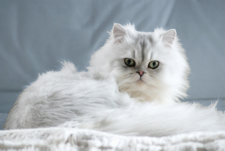|
The Scratching Post
Persian 
The Persian has held the attention of cat enthusiasts since the 1600s and is known as the number one breed in popularity. They look like a soft fluffy ball of fur, but under the full coat lies a muscular, sturdy and cobby body. They have large, round eyes that are set far apart. They have a short, flat nose with a break between the eyes. The eyes come in a variety of brilliant hues. The head is large and round with a smooth dome and sits on a short, thick neck. The ears are round, small and set far apart and low on the head. There are two facial types: Extreme and Traditional or Dollface. The Persian has a very long, flowing and dense coat that sports many colors and patterns. This medium to large breed has short, thick legs and an overall appearance of roundness. The tail is thick and short and is angled down.
|
|
Temperament
|
The Persian has a loving, sweet and laidback personality. They have a gentle devotion and are generally sedate. They are not likely to bounce off the walls or claw to the top of window treatments, though they occasionally enjoy pouncing on a catnip mouse. While they are awake, they like playing, cuddling and being pampered. This breed has a soft and pleasant voice, though it is rarely used. They love to be petted and crave affection, but are not as demanding as other breeds. Persians are very responsive and will become a constant source of joy and delight to their humans.
|
|
Weight
|
Male 9-14 lbs. ; Female 7-11 lbs.
|
|
Health Problems
|
Because of the large and protruding eyes, they are prone to eye infections, injuries and irritations. As with flat-nose breeds, they tend to have breathing problems and can also have clogged tear ducts. White Persian with blue eyes may be born deaf. This breed is also prone to polycystic kidney disease (PKD) and gingivitis.
|
|
Living Conditions
|
Persians make great apartment cats. Their long hair and docile nature make them indoor-only cats. Their long coats pick up debris easy and can snag on bushes, trees and fences. A protected environment is your cat?s safest recourse.
|
|
Exercise
|
This breed should be provided with a scratching post. Adult Persians are not very active or destructive.
|
|
Life Expectancy
|
15 or more years
|
|
Grooming
|
Extensive grooming is necessary with this breed. Daily combing and brushing is advised to reduce knotting and matting. Show kitties require hours and hours of slaving over a cat comb. Daily grooming also prevents intestinal and respiratory problems due to swallowing fur. Missing just one day of grooming can leave you with a tangled, matted and miserable kitty.
|
|
Origin
|
The Persian was first discovered in the early 1600?s by Italian traveler, Pietro della Valle. He brought the first known Persian cats to Italy. By the 1800?s, the breed was imported to France. Shortly after arriving in Britain in the late 1800?s, the breed gained great popularity, even becoming more prized than the previously popular Angora. Today, the Persian is the most popular breed in cat shows, and is known as ?the aristocrat of the cat family.? Nearly 80% of cat registrations in America are contributed by the Persian.
|